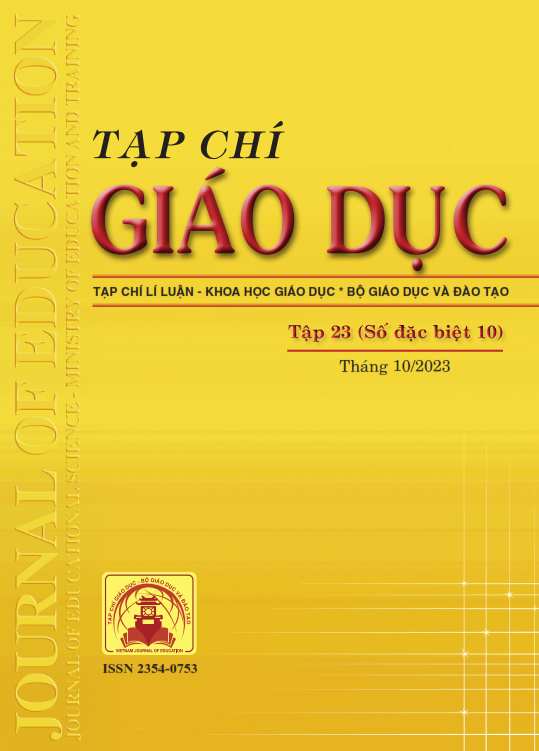Sử dụng thí nghiệm với Arduino trong dạy học: một nghiên cứu tác động về giáo dục STEM
Tóm tắt
During STEM lessons, one of the challenges in scientific inquiry is the lack of equipment for conducting experiments. Therefore, there is a need for cost-effective and flexible solutions that students and teachers can design, create, and use on their own. Additionally, presenting real-life contexts, such as creating experiments for educational purposes, is crucial to stimulate student engagement in the engineering design process, thereby enhancing students' design thinking competence. Hence, integrating STEM education using Arduino devices will develop design thinking skills in students and can be leveraged from the perspective of engineering design processes for devices used in scientific inquiry processes. This research applied two processes developed from theory to successfully construct devices with Arduino and create STEM lessons specifically related to the topic of thermophysics for 12th-grade students. The experimental results also demonstrated the feasibility and effectiveness of the impact on developing students' design thinking competence.
Tài liệu tham khảo
Đỗ Hương Trà (chủ biên), Nguyễn Văn Biên, Tưởng Duy Hải, Phạm Xuân Quế, Dương Xuân Quý (2019). Dạy học và phát triển năng lực môn Vật lí Trung học phổ thông. NXB Đại học Sư phạm.
Dorst, K. (2011). The core of “design thinking” and its application. Design Studies, 32(6), 521-532. https://doi.org/10.1016/j.destud.2011.07.006
Fajrina, S., Lufri, L., & Ahda, Y. (2020). Science, technology, engineering, and mathematics (STEM) as a learning approach to improve 21st century skills: A review. International Journal of Online and Biomedical Engineering, 16(7), 95-104. https://doi.org/10.3991/ijoe.v16i07.14101
García-Tudela, P. A., & Marín-Marín, J. A. (2023). Use of Arduino in Primary Education: A Systematic Review. Education Sciences, 13(2). https://doi.org/10.3390/educsci13020134
Kefalis, C., & Drigas, A. (2019). Web based and online applications in STEM education. International Journal of Engineering Pedagogy, 9(4), 76-85. https://doi.org/10.3991/ijep.v9i4.10691
Kelley, T. R., & Knowles, J. G. (2016). A conceptual framework for integrated STEM education. International Journal of STEM Education, 3(1). https://doi.org/10.1186/s40594-016-0046-z
Kennedy, T. J., & Odell, M. R. L. (2014). Engaging Students In STEM Education. Science Education International, 25(3), 246-258.
Kimbell, L. (2011). Rethinking Design Thinking: Part I. Design and Culture, 3(3), 285-306. https://doi.org/10.2752/175470811x13071166525216
Madden, M. E., Baxter, M., Beauchamp, H., Bouchard, K., Habermas, D., Huff, M., Ladd, B., Pearon, J., & Plague, G. (2013). Rethinking STEM education: An interdisciplinary STEAM curriculum. Procedia Computer Science, 20, 541-546. https://doi.org/10.1016/j.procs.2013.09.316
Micheli, P., Wilner, S. J. S., Bhatti, S. H., Mura, M., & Beverland, M. B. (2019). Doing Design Thinking: Conceptual Review, Synthesis, and Research Agenda. Journal of Product Innovation Management, 36(2), 124-148. https://doi.org/10.1111/jpim.12466
Nikitina, I. P., & Ishchenko, T. V. (2022). About Some Aspects of Stem Education. Pedagogy of the formation of a creative person in higher and secondary schools, 81, 99-103. https://doi.org/10.32840/1992-5786.2022.81.17
O’Sullivan, D., & Igoe, T. (2004). Physical Computing: Sensing and Controlling the Physical World with Computers. Trong Technology. http://www.amazon.ca/exec/obidos/redirect?tag=citeulike09-20&path=ASIN/159200346X
Oberloier, S., & Pearce, J. M. (2018). General design procedure for free and open-source hardware for scientific equipment. Designs, 2(1), 1-15. https://doi.org/10.3390/designs2010002
Plaza, P., Blazquez, M., Perez, C., Castro, M., & Martin, S. (2018). Arduino as an Educational Tool to Introduce Robotics. 2018 IEEE International Conference on Teaching, Assessment, and Learning for Engineering, 1-8.
Razzouk, R., & Shute, V. (2012). What Is Design Thinking and Why Is It Important? Review of Educational Research, 82(3), 330-348. https://doi.org/10.3102/0034654312457429
Rusmann, A., & Ejsing-Duun, S. (2022). When design thinking goes to school: A literature review of design competences for the K-12 level. International Journal of Technology and Design Education, 32(4), 2063-2091. https://doi.org/10.1007/s10798-021-09692-4
Thompson, C. (2011). Build It . Share It . Profit . Can Open Source Hardware Work? 1-4.
Đã Xuất bản
Cách trích dẫn
Số
Chuyên mục
Giấy phép

Tác phẩm này được cấp phép theo Ghi nhận tác giả của Creative Commons Giấy phép quốc tế 4.0 .












